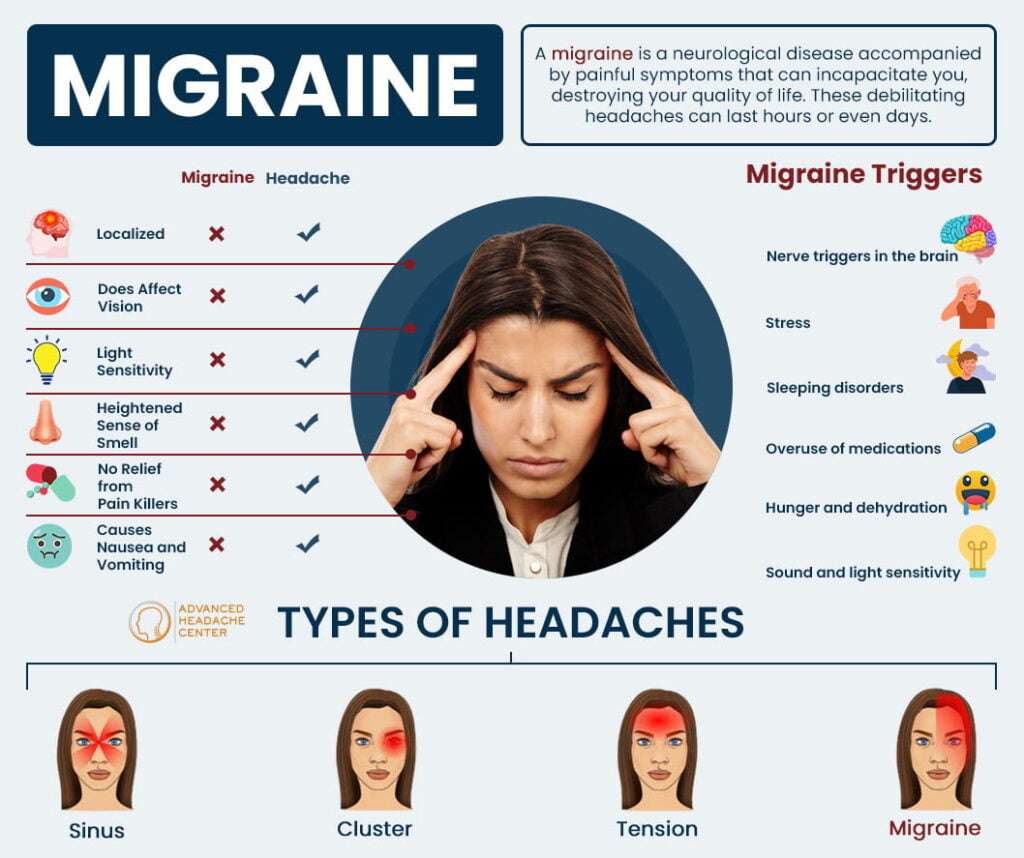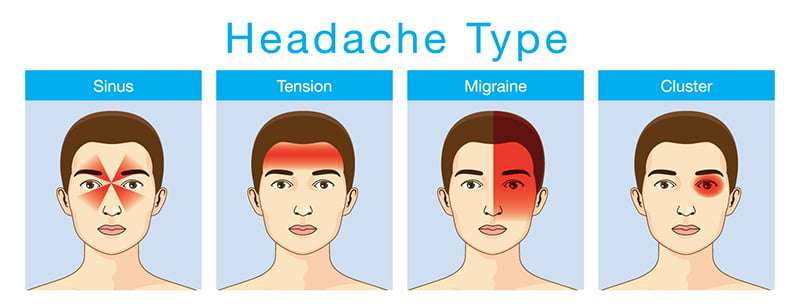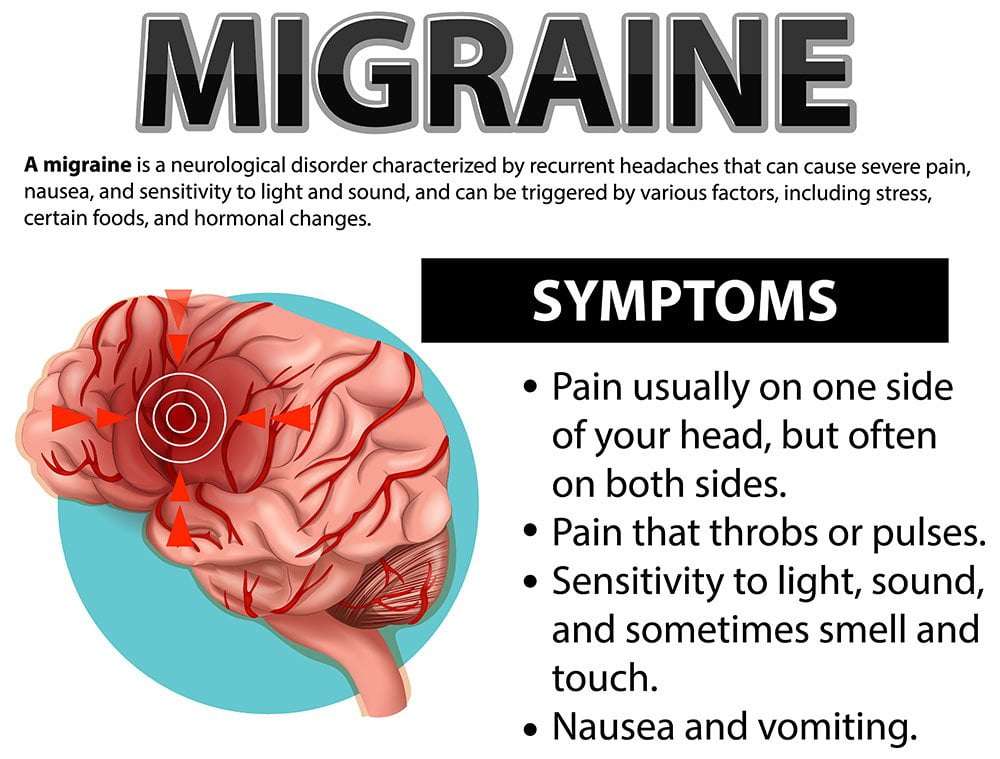
A migraine is much more than a bad headache. It can cause debilitating, throbbing, one-sided head pain that can leave you in bed for days. Movement, lights, sounds, and other triggers may cause symptoms like fatigue, nausea, vision changes, irritability, and more. A healthcare provider can help you manage symptoms so migraines don’t take over your life.
Overview
What is a migraine?
A migraine is a severe headache that causes throbbing, pulsing head pain on one side of your head. The headache phase of a migraine usually lasts at least four hours, but it can also last for days. This headache gets worse with:
- Physical activity.
- Bright lights.
- Loud noises.
- Strong odors.
Migraines are disruptive. They can interfere with your daily routine and affect your ability to meet personal and social obligations. Treatment is available to help you manage migraines.
What are the types of migraines?
There are several types of migraines. The most common migraine categories are:
- Migraine with aura (classic migraine).
- Migraine without aura (common migraine).
An aura is a phase of the migraine before head pain begins.
Other types of migraines include:
- Migraines in children (abdominal migraine).
- Chronic migraine.
- Hemiplegic migraine.
- Menstrual migraine.
- Migraine without headache (silent migraine).
- Retinal migraine (ocular migraine).
- Status migrainosus.
How common are migraines?
Migraines are common. Studies show that an estimated 12% of people in the United States experience migraines.

Symptoms and Causes
What are the phases of a migraine?
There are four phases or stages of a migraine:
- Prodrome: The first phase begins up to 24 hours before you experience a headache.
- Aura: An aura is a group of sensory, motor, and speech symptoms that are a warning sign of a migraine headache. The aura phase can last as long as 60 minutes or as little as five. You might experience both the aura and the headache at the same time.
- Headache: A migraine headache lasts between four hours to 72 hours.
- Postdrome: The postdrome stage usually lasts for a few hours up to 48 hours. Symptoms feel similar to an alcohol-induced hangover, which is why the postdrome phase is known as a migraine hangover.
It can take about eight to 72 hours to go through the four stages.
Migraine symptoms

Migraine symptoms vary based on the stage. Every migraine is different, and you won’t necessarily experience symptoms during all four phases of every migraine.
Prodrome symptoms
- Mood changes.
- Difficulty concentrating.
- Trouble sleeping.
- Fatigue.
- Nausea.
- Increased hunger and thirst.
- Frequent urination.
Aura symptoms
- Muscle weakness.
- Vision changes.
- Ringing in your ears (tinnitus).
- Sensitivity to touch (feeling like someone is touching you).
- Numbness and tingling.
- Difficulty speaking or concentrating.
Headache attack symptoms
Head pain gradually gets more intense. It can affect one side of your head or both. It can occur with other symptoms like:
- Nausea and vomiting.
- Light, sound, and odor sensitivity.
Postdrome symptoms
- Fatigue.
- Stiff neck.
- Sensitivity to light and sound.
- Difficulty concentrating.
- Nausea.
- Dizziness.
What does a migraine feel like?
Migraine headache pain may feel like the following:
- Throbbing.
- Pulsing.
- Pounding.
- Dull.
A migraine can feel different for each person. A migraine headache ranges from mild to severe. Head pain can start on one side and shift to the opposite side. You may also have pain around your eyes or temple, and sometimes, around your face, sinuses, jaw, or neck.
How often do migraines happen?
The frequency of migraine varies from person to person. You might have one migraine per year or one per week. On average, most people experience two to four per month. They’re most common in the morning. Most migraines are unpredictable, but sometimes, you can have an idea of when a migraine will happen, like before menstruation or after feeling stressed.
What causes a migraine?
Researchers aren’t sure of the exact cause of migraines, but studies show genetics play a role.
When you have a headache, specific nerves in your blood vessels send pain signals to your brain. This releases inflammatory substances into your head’s nerves and blood vessels. It’s unclear why your nerves do that.
What triggers a migraine?
A trigger is something that causes symptoms to start. Some of the most common migraine triggers include:
- Stress.
- Hormonal changes.
- Certain medications.
- Changes to your sleep.
- Weather conditions change.
- Too much physical activity (overexertion).
- Addictive substances like caffeine or tobacco.
- Missing a meal.
- Exposure to bright lights, loud noises, or strong odors.
Your healthcare provider can help you identify your triggers. They might recommend keeping a migraine journal to track similarities between migraine attacks.
What foods trigger migraines?
Your body may have a sensitivity to specific chemicals and preservatives in foods. This sensitivity makes a migraine more likely to happen, especially if combined with other triggers.
Some of the most common food triggers include:
- Aged cheese.
- Beverages containing alcohol.
- Chocolate.
- Food additives like nitrates and MSG.
- Processed or cured foods (hot dogs, pepperoni).
- Fermented or pickled foods.
Are migraines hereditary?
Yes, migraines tend to run in biological families. Up to 80% of people with migraines have a first-degree biological relative with the condition.
What are the risk factors for a migraine?
A migraine can affect anyone at any age, from children to adults. Women and people assigned female at birth are more likely than men and people assigned male at birth to experience a migraine.
Other risk factors that may make you more likely to experience a migraine include:
- Biological family history of migraines.
- Underlying medical conditions (depression, anxiety, sleep disorders, and epilepsy).
- Regular use of tobacco products.






Thank you for your articles. I find them very helpful. Could you help me with something?
Sure
You’ve the most impressive websites.
Thank you.. Your valuable comments are our pleasure. Please share our website with your friends.
One more thing is that when evaluating a good on the internet electronics store, look for online shops that are continually updated, trying to keep up-to-date with the hottest products, the top deals, and also helpful information on product or service. This will make certain you are getting through a shop that really stays atop the competition and offers you what you need to make intelligent, well-informed electronics expenditures. Thanks for the significant tips I have really learned through your blog.
You actually make it seem so easy along with your presentation but I to find this matter to be really one thing which I think I might never understand. It kind of feels too complicated and extremely vast for me. I am having a look forward on your subsequent submit, I抣l try to get the cling of it!
I have observed that car insurance providers know the automobiles which are prone to accidents along with other risks. Additionally they know what type of cars are given to higher risk and the higher risk they have got the higher a premium rate. Understanding the basic basics regarding car insurance will let you choose the right type of insurance policy that can take care of the needs you have in case you become involved in an accident. Thanks for sharing the ideas on your blog.
Hello! I know this is kinda off topic but I’d figured I’d ask. Would you be interested in exchanging links or maybe guest authoring a blog article or vice-versa? My website covers a lot of the same topics as yours and I think we could greatly benefit from each other. If you’re interested feel free to shoot me an email. I look forward to hearing from you! Superb blog by the way!
I do not even understand how I stopped up here, however I thought this put up was once good. I don’t understand who you are but definitely you’re going to a well-known blogger should you aren’t already 😉 Cheers!
I want to thank you for your assistance and this post. It’s been great.
Hmm it appears like your site ate my first comment (it was super long) so I guess I’ll just sum it up what I submitted and say, I’m thoroughly enjoying your blog. I too am an aspiring blog blogger but I’m still new to everything. Do you have any helpful hints for novice blog writers? I’d really appreciate it.
Hey very nice website!! Man .. Excellent .. Amazing .. I will bookmark your I’m happy to find numerous useful info here in the post, we need develop more techniques in this regard, thanks for sharing. . . . . .
Hi, i think that i saw you visited my blog so i came to 搑eturn the favor?I’m attempting to find things to enhance my site!I suppose its ok to use some of your ideas!!
of course like your web-site but you have to check the spelling on quite a few of your posts. Several of them are rife with spelling issues and I find it very troublesome to tell the truth nevertheless I will surely come back again.
Thanks for your write-up on this site. From my experience, there are occassions when softening upwards a photograph could possibly provide the digital photographer with a dose of an imaginative flare. Sometimes however, that soft blur isn’t what exactly you had in your mind and can often times spoil a normally good picture, especially if you intend on enlarging that.
I am really impressed with your writing skills as well as with the layout on your weblog. Is this a paid theme or did you modify it yourself? Anyway keep up the nice quality writing, it is rare to see a nice blog like this one these days..
I know this if off topic but I’m looking into starting my own weblog and was wondering what all is required to get setup? I’m assuming having a blog like yours would cost a pretty penny? I’m not very internet smart so I’m not 100 certain. Any tips or advice would be greatly appreciated. Thanks
I love your blog.. very nice colors & theme. Did you design this website yourself or did you hire someone to do it for you? Plz answer back as I’m looking to design my own blog and would like to find out where u got this from. kudos
Very nice post. I just stumbled upon your weblog and wished to say that I have truly enjoyed surfing around your blog posts. In any case I will be subscribing to your rss feed and I hope you write again very soon!
Spot on with this write-up, I actually assume this website wants rather more consideration. I抣l most likely be again to learn rather more, thanks for that info.
Pretty nice post. I just stumbled upon your weblog and wanted to say that I have truly enjoyed surfing around your blog posts. In any case I抣l be subscribing to your feed and I hope you write again very soon!
Great article. It is extremely unfortunate that over the last decade, the travel industry has already been able to to handle terrorism, SARS, tsunamis, influenza, swine flu, plus the first ever true global recession. Through everything the industry has proven to be sturdy, resilient along with dynamic, finding new ways to deal with trouble. There are continually fresh challenges and opportunity to which the industry must again adapt and react.
Thank You… https://lifehealth.website/shope/
Good shout.
Good shout.
Nice
Nice